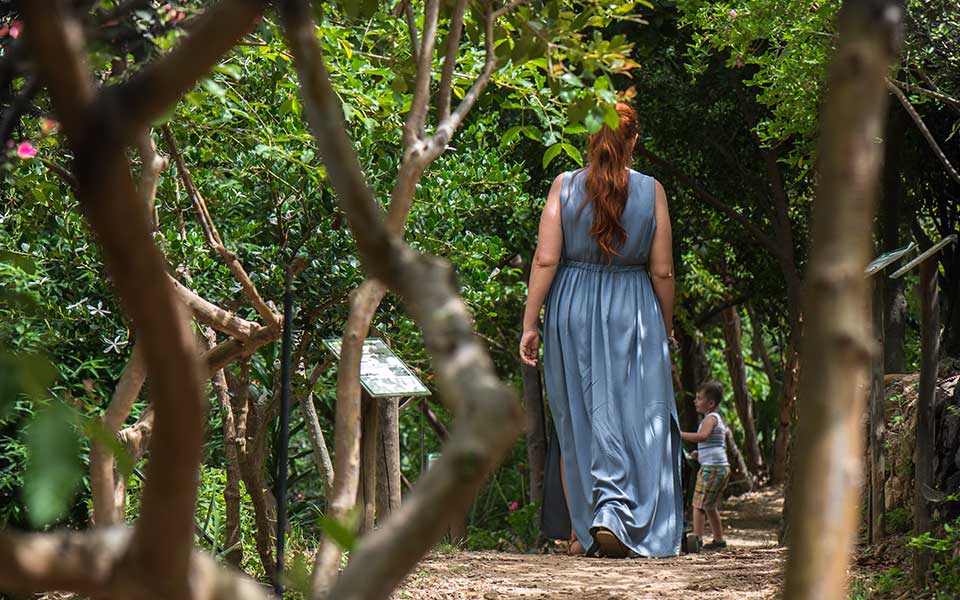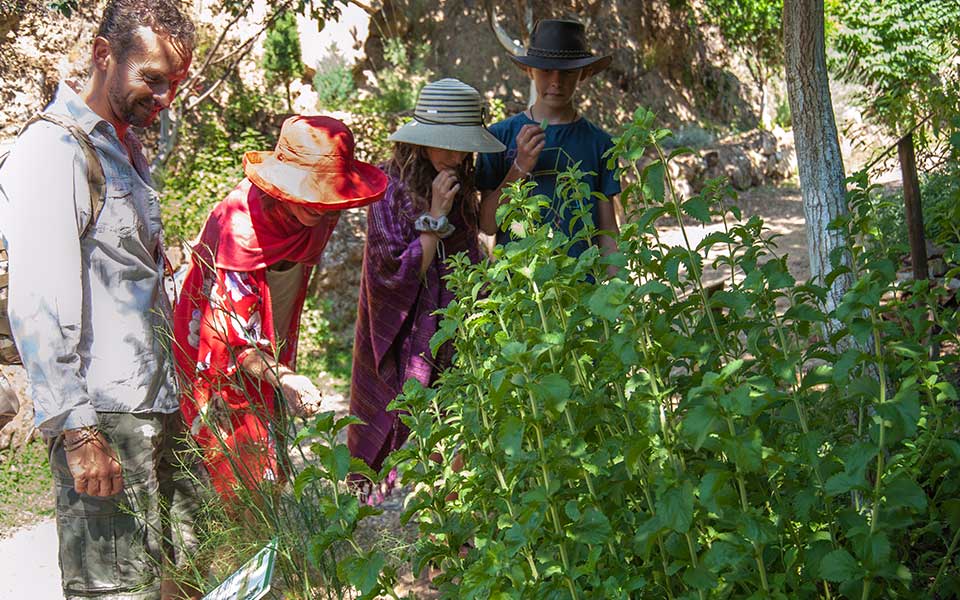Meet the Souvlaki Wrapper Who’s Served Athens for...
Discover how Christos, Athens’ master souvlaki...

Alongside herds of sheep and goats on the move, another common hazard encountered on Crete’s back roads is suddenly finding yourself behind an empty car, inexplicably stopped. Chances are you’ll find the owner foraging in the thick undergrowth beyond the shoulder of the road. Depending on the time of year, they might emerge with bagfuls of wild greens, herbs, or other seasonal delicacies such as mushrooms, wild asparagus, or snails.
This inherited knowledge of the land – what it offers, when and where to find it, and how to cook it – is a hallmark of the Cretan Diet. There’s an old saying that goes something like, “When the donkey starves, the Cretan gets fat,” meaning that while the donkey only eats the top leaves of a plant, his owner will eat the roots as well.
The concept of the Cretan Diet emerged from the 1950s Seven Countries Study, led by American psychologist Ancel Keys. Keys saw the early warning signs of his compatriots’ obesity and heart health problems and set out to find the world’s healthiest cuisines. His research established that Cretans boasted the lowest levels of heart disease in Europe and remarkable longevity rates, thanks to their reliance on seasonal fruit and vegetables, their sparing consumption of meat, and the copious quantities of olive oil they ingest.

The flexibility of this diet had an additional benefit; it prevented the island’s multiple invaders from ever fully pacifying the Cretans, as the locals knew how to find enough nutrition to fuel sporadic rebellions even when driven into the high mountains.
Growing up in a traditional village overlooking the Hania valley in the foothills of the White Mountains, restaurateur Petros Marinakis was a child of the generation that Key studied, raised on that traditional Cretan diet. He recalls, “There are still people in my village who think you’re crazy if you eat a tomato in winter. For my parents’ generation, the idea of the supermarket was mad. They couldn’t understand why you would go inside to get food that grows all around you outside.”
For Marinakis, it’s more a philosophy than cuisine. As you only eat what is in season and available, you aren’t bound by set recipes. Missing a particular ingredient doesn’t stop you from making a dish; it encourages you to adapt, find an alternative, and trust your culinary instincts. And it’s not just about food, either.


“Our diet has six pillars,” the restaurateur explains. “The first is walking. When I was growing up, people would regularly walk 10-20km a day. If you needed something extra for the pot, you went out and found it. The second is eating only fruits and vegetables that are in season. And the third is olive oil; my family used 300 liters a year between the seven of us, which was nearly half our caloric intake. “The fourth is not much meat. My mother would cook meat on Sundays and for celebrations only. The fifth is ‘no recipes’. You use your experience and imagination. The sixth is wine. My parents would have a glass of wine with lunch and in the evening every day.”
By the early 2000s, Marinakis had established a number of successful restaurants on the coast west of Hania. He watched the changes in his contemporaries’ tastes and their attitudes to food with increasing concern. Even as health-conscious foreigners began to adopt elements of the Cretan Diet, the eating habits of modern Greeks were becoming increasingly similar to their European contemporaries – fast and meat-heavy.
“We had children, even Cretan children, at our hotel and restaurant who didn’t know if oranges grew on trees or underground like potatoes,” Marinakis says. “I saw people increasingly living in boxes, in an almost virtual reality. After thousands of years, we are now, over the course of a few generations, losing our connection to the land and our culture, a culture that dates back all the way back to the Minoans, who first cultivated olives here.”

Petros Marinakis
In 2003, a devastating fire destroyed extensive family-owned olive groves in the valley, some with trees dating back thousands of years. Marinakis saw the fire as an opportunity to do something about the evolving food scene. With three distinct microclimates – semi-tropical, Mediterranean and alpine – present in the valley, he knew that he could grow almost anything. So, much to the incredulity of his neighbors, instead of replanting olives he created a 20-hectare botanical garden with a restaurant and shop attached to it; the enterprise opened in 2010.
Today, the now well-established garden draws thousands of visitors every year. The planting has been cleverly conceived, with high paths lined with an impressive display of semi-tropical trees from Asia, Africa, South America and Australasia that can survive the local climate. Planted on the outside of the paths, the trees provide dappled shade for more delicate shrubs, herbs and spice plants to thrive underneath. Visitors wind their way up and down the valley paths, sniffing, rubbing, and admiring plants they either never knew existed or wouldn’t have expected to find in Europe. It takes a good two to three hours to see the whole garden – but the terraced restaurant that greets visitors as they finish their explorations is as big a draw as the garden itself.

Marinakis has put together a trusted kitchen team, people from the surrounding villages he’s grown up with and who, most importantly, he says, “remember how their grandparents cooked.” Dishes are prepared over traditional open wood fires, slow-cooked to give flavors the chance to mingle and merge. All ingredients (except the Greek rice) come from within a 20-mile radius of the garden, while the harvest from the garden itself gives traditional dishes an exotic twist.
As you’d expect, the menu changes with the seasons and the produce available. So your seasonal green vegetable and fruit salad – Kouzoulos – may feature the dragon fruit or black sapote (Mexican chocolate pudding fruit) you admired in the garden earlier, depending on when you visit.
The wood-fired dishes are served with organic Cretan olive oil, and the rice and vegetables are flavored with herbs from Asia and South America that harmonize with Cretan stalwarts. Cretan wines are increasingly palatable to broader European tastes as a new generation of growers establish varieties that thrive in the rich red island soils.

Of the whites, Vidiano is light and aromatic and a rising star, while the traditional island grape Romeiko has acquired a new lease on life. Growing red but maturing white, Romeiko is the basis of the more robust Marouvas-style wines favored by the older generations but recently has found newfound popularity in a 12.5% ABV sparkling varietal.
These wines and an extensive range of strictly local produce, are also available in the shop to pick up on your way out, fulfilling another of Marinakis’ missions: celebrating the quality of local food and supporting a circular economy by reducing transport distance. “With climate change, young people are getting more and more aware. They understand the reality that everything is interconnected. They want to know where their food comes from and who grows it. Here, we have to do two things – we need preserve traditional dishes and cooking methods, no compromise, and at the same time, we need to create new dishes, new combinations of ingredients, tastes, and flavors with what we have at our disposal. If we can get people curious about their food, they become curious about where it comes from, and that’s the essence of the modern Cretan Diet.”
The Botanical Garden of Crete, Fournes 730 05, Crete
Tel. (+30) 28212.007.70, οpen April-October
Restaurant is open: 09:00-18:00
A 30-minute drive into the mountains from the city of Hania or its airport; there are direct buses from the Hania Bus Station as well.
Discover how Christos, Athens’ master souvlaki...
This article explores four cozy Greek...
Souvlaki joints started appearing in earnest...
Discover Crete’s iconic sarikopites – delicate...